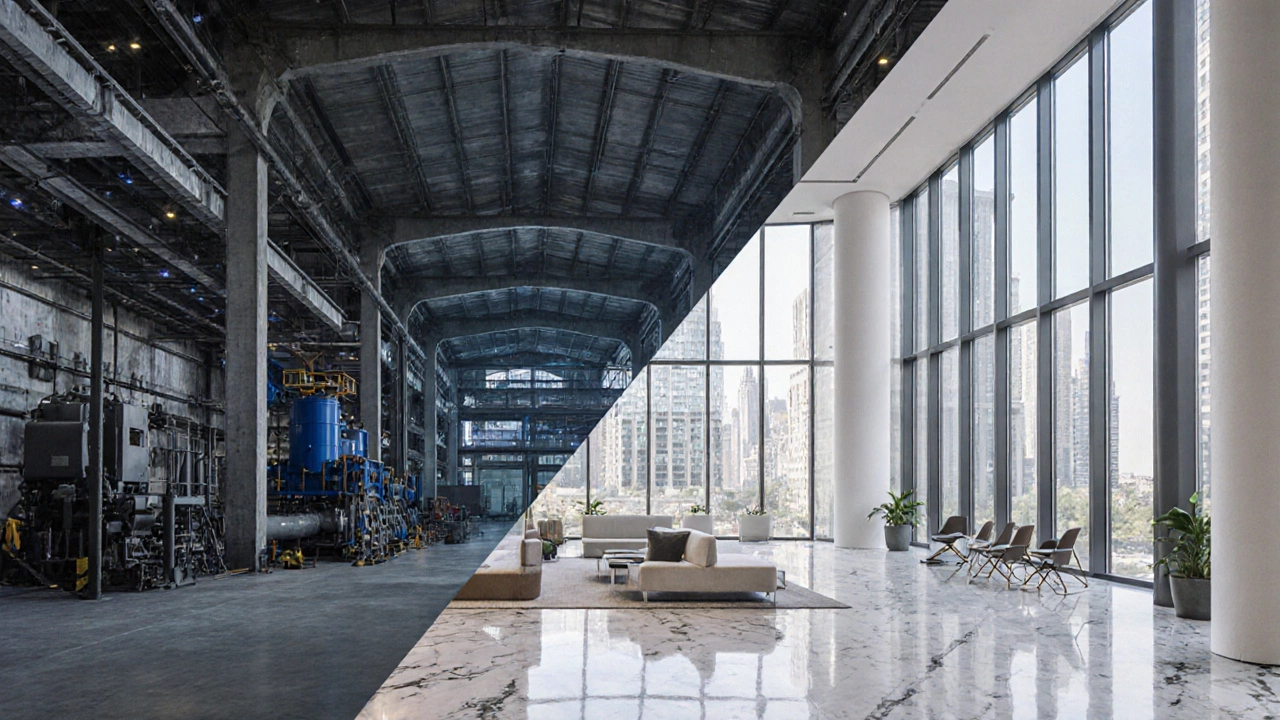Construction Differences: The Basics You Need to Know
Ever wonder why a house looks so different from a warehouse or a school? The answer lies in the construction differences that guide every build. From the choice of material to the way the frame is put together, each project follows its own rule book. Understanding these differences helps you pick the right contractor, budget accurately and avoid costly surprises.
Residential vs. Commercial – What Changes?
When you build a home, the focus is on comfort, style and long‑term durability. Wood framing (think Type 5 construction) is common because it’s cheap, easy to work with and provides good insulation. Residential walls usually have a 2×4 or 2×6 stud layout, and the roof pitch is designed for drainage and aesthetics.
Commercial buildings, on the other hand, prioritize speed, load‑bearing capacity and fire safety. Steel or concrete frames dominate because they can support larger floor plates and resist fire longer. You’ll see flat roofs, large open bays and a lot of glass to let in daylight. The walls are often built with metal studs and a concrete core for extra rigidity.
Industrial and Specialized Projects – Heavy‑Duty Rules
Factories, warehouses and data centres need a different approach. The main goal is to handle heavy equipment, high traffic and sometimes extreme temperatures. Reinforced concrete slabs and steel columns are the norm, and floor load ratings are much higher than in homes or offices. Ceiling heights are generous, and the construction often includes specialized flooring, vibration dampening and robust fire‑suppression systems.
Even within the same category, you’ll find variations. A boutique hotel might blend residential finishes with commercial structural systems, while a modern school could mix steel frames with wood interior walls for a warm feel. These hybrid solutions illustrate how construction differences are not rigid, but adaptable to design goals.
So why should you care? Knowing the main differences lets you ask the right questions when you talk to a builder. If you’re adding a garage door to a residential house, you’ll need a timber or light‑steel frame that can handle the door’s weight without compromising the wall’s integrity. For a commercial property, the installer must check the steel beam layout and fire‑rating compliance before fitting the door.
Here are three quick tips when evaluating a project:
- Check the material list. Wood, steel or concrete each have distinct maintenance needs.
- Ask about load ratings. Knowing how much weight the floor or wall can hold prevents future failures.
- Confirm fire‑rating requirements. Residential, commercial and industrial codes differ, and non‑compliance can void insurance.
In short, construction differences are about matching the building’s purpose with the right structure, materials and methods. Keep these basics in mind, and you’ll be better equipped to make smart decisions, whether you’re renovating a kitchen, installing a garage door or planning a new office space.

Industrial vs Commercial Construction: Are They the Same?
Oct 9, 2025, Posted by Damon Blackwood
Explore the differences between industrial and commercial construction, covering purpose, regulations, costs, timelines, and how to pick the right contractor.
MORE
Commercial vs Residential Buildings: Real Differences That Matter
May 14, 2025, Posted by Damon Blackwood
Trying to figure out the real differences between commercial and residential buildings? This article breaks it down in simple terms—think purpose, design, rules, and money talk. Get practical tips on what matters for property owners, builders, and anyone eyeing real estate. No jargon, just facts you can use if you’re thinking about construction or investing. Get clear insights to help you make smart decisions.
MORE
What is the Opposite of Commercial Construction? Breaking Down the Basics
Apr 21, 2025, Posted by Damon Blackwood
If you’ve ever wondered what stands on the other side of commercial construction, this article breaks it all down in clear terms. We’ll look at what makes commercial projects different from their opposite—residential construction—and why that matters. Discover how the aims, requirements, and day-to-day challenges compare. You’ll walk away knowing when a job is considered commercial or residential, and why these lines matter for budgets and building codes. Useful facts and straightforward tips are packed in for anyone curious about the construction world.
MORE
Exploring the Differences: Commercial vs. Non-Residential Construction Explained
Nov 11, 2024, Posted by Damon Blackwood
Commercial and non-residential construction terms are often used interchangeably, yet they entail subtle differences essential for contractors, developers, and stakeholders to understand. This article unravels these nuances by examining what makes commercial construction unique, its legal and regulatory aspects, and how they differ from other non-residential projects. Discover interesting insights into various commercial structures like malls, office buildings, and warehouses, and learn practical tips for navigating these developments. Understanding these distinctions can enhance project execution and planning efficiency.
MORESEARCH HERE
Categories
TAGS
- foundation repair
- construction
- commercial construction
- new builds
- home improvement
- home renovation
- bathroom renovation
- construction materials
- home foundation
- renovation tips
- residential construction
- building types
- contractor
- foundation cracks
- home construction
- architectural services
- construction differences
- home inspection
- kitchen installation
- real estate